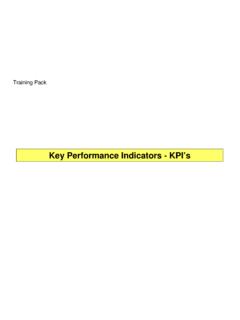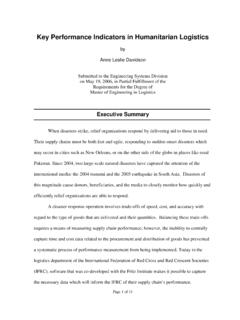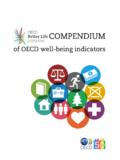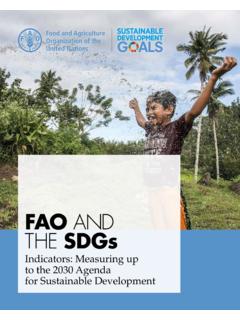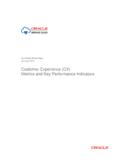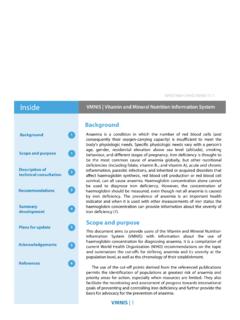Transcription of A review of indicators and methods to assess …
1 A review of indicators and methods to assess biodiversity Application to livestock production at global scale A review of indicators and methods to assess biodiversit Application to livestock production at global scale Recommended Citation Teillard, F., Anton, A., Dumont, B., Finn, , Henry, B., Souza, , Manzano P., Mil i Canals, L., Phelps, C., Said, M., Vijn, S., White, S. 2016. A review of indicators and methods to assess biodiversity Application to livestock production at global scale. Livestock Environmental Assessment and Performance (LEAP) Partnership. FAO, Rome, Italy. These document will be regularly updated. To verify if this version is the most recent, please visit page The designations employed and the presentation of material in this information product do not imply the expression of any opinion whatsoever on the part of the Food and Agriculture Organization of the United Nations (FAO) concerning the legal or development status of any country, territory, city or area or of its authorities, or concerning the delimitation of its frontiers or boundaries.
2 The mention of specific companies or products of manufacturers, whether or not these have been patented, does not imply that these have been endorsed or recommended by FAO in preference to others of a similar nature that are not mentioned. The views expressed in this information product are those of the author(s) and do not necessarily reflect the views or policies of FAO. FAO, 2016. FAO encourages the use, reproduction and dissemination of material in this information product. Except where otherwise indicated, material may be copied, downloaded and printed for private study, research and teaching purposes, or for use in non-commercial products or services, provided that appropriate acknowledgement of FAO as the source and copyright holder is given and that FAO's endorsement of users' views, products or services is not implied in any way. All requests for translation and adaptation rights, and for resale and other commercial use rights should be made via or addressed to FAO information products are available on the FAO website ( ).
3 And can be purchased through Table of contents Acknowledgements v Abbreviations ix Glossary xi PART 1. INTRODUCTION 1. 1. LIVESTOCK & biodiversity 3. The influences of livestock on biodiversity 3. The importance of biodiversity 4. The need for quantitative indicators 5. 2. OBJECTIVE 7. PART 2. THE PRESSURE-STATE-RESPONSE indicator FRAMEWORK 9. 3. THE PRESSURE-STATE-RESPONSE FRAMEWORK 11. 4. PRESSURES, BENEFITS AND THEIR indicators 13. Habitat change 13. Pressure: habitat destruction and fragmentation 13. Benefit: extensive use, habitat creation and maintenance 17. Pressure: habitat degradation 20. Benefit: habitat restoration 22. Pressure: detrimental practices and intensity 23. Pressure: Landscape homogenization 26. Benefit: Landscape connectivity 28. Pollution 30. Pressure: Soil and water pollution 30. Benefit: Nutrient cycling 31. Pressure: Atmospheric nitrogen pollution 32. Pressure: Pesticides and other products 32. Climate change 33. Pressure: GHG emissions 33.
4 Benefit: GHG sequestration 34. Other drivers 35. Pressure: Invasive species 35. Benefit: Invasive species control 36. Pressure: Overexploitation of wild populations 36. iii A review of indicators and methods to assess biodiversity Pressure: Competition with large mammals 37. Benefit: Food web maintenance 37. Pressure: Disease emergence 38. Benefit: Disease control 39. 5. STATE indicators 40. State indicators at the species level 40. Composition dimension 41. Structural dimension 42. Functional group dimension 43. State indicators at the ecosystem level 44. Compositional dimension 44. Structural dimension 45. Functional dimension 45. State indicators at the gene level 46. State indicators at regional to global scale 46. Remotely sensed vegetation indices 46. Living Planet Index 48. The IUCN Red Lists and Red List Indices 48. Farmland bird indices 49. 6. RESPONSE indicators 50. Actions from the public sector 50. Actions from the private sector 51. 7.
5 STRENGHTS AND LIMITATIONS OF THE PSR indicator FRAMEWORK 53. Strengths 53. Limitations 54. PART 3. THE LIFE CYCLE ASSESSMENT FRAMEWORK 57. 8. OVERVIEW 59. LCAs of livestock production 59. LCA methodologies addressing biodiversity endpoints 61. 9. THE ASSESSMENT OF LAND USE IMPACTS ON biodiversity IN LCA 62. Conceptual framework 62. General situation 62. Specific situations in the context of livestock production 64. Using species-area relationships to compute characterization factors 64. Examples of land use impact assessment models 65. The Ecological Damage Potential 65. The ReCiPe methodology 67. The Mean Species Abundance 68. The UNEP-SETAC life cycle initiative 69. iv 10. EXAMPLES OF IMPACT ASSESSMENT MODELS FOR OTHER MIDPOINT. CATEGORIES LINKED TO biodiversity 70. Acidification and eutrophication 70. Acidification 70. Eutrophication 71. Climate change 71. Water use 72. Ecotoxicity 72. 11. STRENGTHS AND LIMITATIONS OF THE LCA FRAMEWORK 74. Strengths 74.
6 Limitations 74. Pressure and benefit categories 76. Spatial coverage and resolution 77. biodiversity coverage 77. PART 4. CONCLUSION 79. 12. COMPLEMENTARITIES BETWEEN FRAMEWORKS 81. Complementarities of scope 81. Complementarities of perspective 81. Complementarities along the environmental cause-effect chain 82. 13. CONCLUDING REMARKS 84. BIBLIOGRAPHY 85. APPENDICES. APPENDIX 1: SYSTEMATIC review METHOD 119. APPENDIX 2: MEAN SPECIES ABUNDANCE VALUES OF DIFFERENT LAND USES 120. APPENDIX 3: OTHER FRAMEWORKS 121. From academic research 121. From intergovernmental organizations 122. The FAO Sustainability Assessment for Food and Agriculture (SAFA) 122. The WRI Corporate Ecosystem Service review 122. From non-governmental organizations 122. High Conservation Value (HCV) approach 122. The IUCN Red List of Ecosystems 123. The InVEST model 125. From the private sector 125. Sustainable Agriculture Initiative Platform (SAI Platform) 125. International Dairy Federation 126.
7 V Global roundtable for sustainable beef 126. Field to Market: The Alliance for Sustainable Agriculture 126. Innovation Center for Dairy 126. The Dairy Sustainability Framework 126. Nestl Commitment on Natural Capital 127. Unilever 127. Restoration and revegetation initiatives 127. Landcare International 127. COMDEKS - Community Development and Knowledge Management for the Satoyama Initiative 127. USDA Restore Conserve Program 128. References 128. vi Acknowledgements AUTHORSHIP AND DEVELOPMENT PROCESS. This review is a product of the Livestock Environmental Assessment and Perfor- mance (LEAP) Partnership. The initial objective of this review was to provide the members of the LEAP Technical Advisory Group (TAG) on biodiversity with a common ground of knowledge on the main biodiversity indicators and assessment methods applicable to livestock production. The objective of this group was to develop Principles for the assessment of livestock impacts on biodiversity (LEAP.)
8 biodiversity principles, FAO, 2016). This document went indeed beyond its initial objective, providing an important body of information on biodiversity assessment which could be useful to stakeholders in the livestock and related sectors. This technical review was initially drafted by F lix Teillard (FAO, Italy; INRA, France) as a preparatory document for the LEAP Technical Advisory Group (TAG) on biodiversity . Once the initial draft was shared with TAG members, the following task force led by F lix Teillard was formed for the finalization of this report: Assumpci Anton (IRTA, Spain); Bertrand Dumont (INRA, France); John Finn (Teagasc, Ireland); Beverley Henry (Queensland University of Technology, Australia); Danielle Maia De Souza (Swedish University of Agricultural Sciences, Sweden); Pablo Manzano (IUCN CEM, Kenya; UAM, Spain); Lloren Mil i Ca- nals (UNEP, France); Catherine Phelps (Dairy Australia, Australia); Mohammed Said (ILRI, Kenya); Sandra Vijn (WWF, USA); and Shannon White (Government of Alberta, Canada).
9 The LEAP Secretariat coordinated and facilitated the work of this task force within the biodiversity TAG, and guided and contributed to the development of its content. The LEAP secretariat, hosted at FAO, was composed of: Pierre Gerber (Coordinator); Camillo De Camillis (Manager); Carolyn Opio (Technical officer);. F lix Teillard (Technical officer); and Aimable Uwizeye (Technical officer). The LEAP Steering Committee provided overall guidance for the activities of the Partnership and helped review and clear the principles for public release. Dur- ing development of the principles the LEAP Steering Committee was composed of: STEERING COMMITTEE MEMBERS. Monikka Agarwal (World Alliance of Mobile Indigenous People, in LEAP since Oct 2014); Douglas Brown (World Vision); Giuseppe Luca Capodieci (The Eu- ropean Livestock And Meat Trading Union, International Meat Secretariat); Ca- millo De Camillis (FAO); Richard de Mooij (The European Livestock And Meat Trading Union, International Meat Secretariat); Elsa Delcombel (Government of France); Lalji Desai (World Alliance of Mobile Indigenous People - 2014 LEAP.)
10 Chair); Pierre Gerber (FAO - LEAP Secretariat Coordinator until Jan 2015); Math- ias Ginet (Government of France, in LEAP since Oct 2014); Jan Grenz (Bern Uni- versity of Applied Sciences, Government of Switzerland, in LEAP until Mar 2014);. Vincent Guyonnet (International Egg Commission); Dave Harrison (International Meat Secretariat); Matthew Hooper (Government of New Zealand); Hsin Huang vii (International Meat Secretariat); Delanie Kellon (International Dairy Federation);. Lionel Launois (Government of France); Pablo Manzano (International Union for Conservation of Nature); Nicolas Martin (European Feed Manufacturers' Federa- tion; The International Feed Industry Federation); Ian McConnel (World Wide Fund for Nature, in LEAP since Jan 2015); Paul Melville (Government of New Zealand); Paul McKiernan (Government of Ireland); Frank Mitloehner (Univer- sity of California, Davis; The International Feed Industry Federation, 2013 LEAP. Chair); Anne-Marie Neeteson-van Nieuwenhoven (International Poultry Council).










